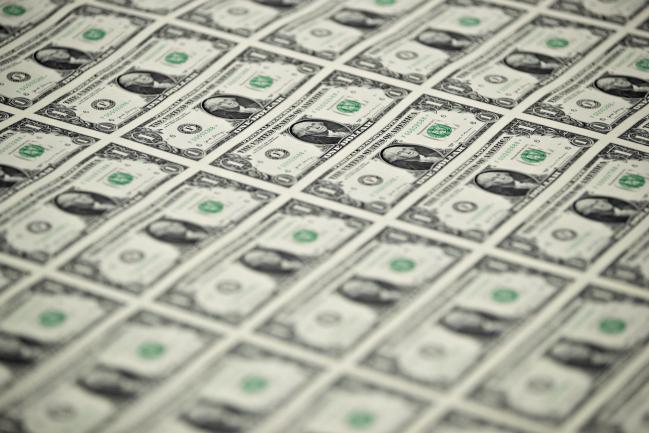(Bloomberg) -- Foreign-exchange investors who grew accustomed to a one-way dollar trade over the past year suddenly face a new challenge: a sideways market.
A widely tracked gauge of the U.S. currency has been confined to a range of just 3 percent over the past two months, displaying signs of exhaustion after plunging as much as 15 percent since the start of 2017. The U.S. Dollar Index was up 0.6 percent in Tuesday trading in New York.
Yet even with analysts showing little confidence in a breakout by the end of next quarter, potential triggers that could free the dollar from its straitjacket lurk on the horizon.
The Tailwinds
1. Inflation: A sustained uptick would fuel more aggressive expectations for Fed policy tightening, supporting the dollar, analysts say. With U.S. consumer prices hovering around the central bank’s two percent target over the past six months, market participants will be keeping a close eye on the Fed’s economic projections due Wednesday for clues as to how officials see inflation -- and interest rate expectations -- progressing.
“We’re going to start to see higher inflation prints on a year-over-year basis in April, May and June,” said Thierry Wizman, a strategist at Macquarie Capital Inc. “People will start maybe thinking a little bit more constructively about Fed hikes and that could help the dollar.”
2. Trade tension: The threat of a global trade war looms after new White House economic adviser Larry Kudlow indicated last week the U.S. was readying a larger round of tariffs against Chinese imports following the announcement of duties on steel and aluminum. A full-blown trade war could wipe out $470 billion from global gross domestic product by 2020, Bloomberg Economics estimates. The damage to exports among America’s trading partners would likely fuel greenback gains, according to Erik Nelson, a currency strategist at Wells Fargo Securities LLC.
“The U.S. runs trade deficits with a lot of other countries, and to the extent that those imbalances could narrow, that would be generally dollar supportive,” said Nelson. “If we do have a trade war and equities continue to weaken more perceptibly, you’d probably see a bigger pickup in the U.S. dollar. The U.S. is probably the best-positioned in the case of a trade war to probably be hurt the least.”
3. Positioning: Traders turned bearish on the greenback in June 2017 and continue to bet on further weakness, Commodity Futures Trading Commission data show. Dollar risk reversals, a gauge of sentiment and market positioning, have been sliding since 2015, briefly turning bearish on the greenback in January. Should futures and options traders become disappointed by the lack of momentum and cover short dollar positions, the U.S. currency could rapidly break out of its range to the upside.
The Headwinds
1. Monetary-policy convergence: Changing signals by central bankers outside the U.S. may inspire dollar selling as global growth accelerates. Conjecture about the timing of a European Central Bank rate hike received a shot in the arm Monday amid reports policy makers are shifting their debate to the future path of rate hikes, and are comfortable with market forecasts for an increase by mid-2019. Amid ongoing whispers the Bank of Japan will eventually begin to dial back its own quantitative easing, the yen has outperformed every Group-of-10 currency this year.
2. Trade wars (again): Analysts are far from agreement on the ultimate impact rising global trade tension will have on the dollar. Near-term, fears over increased U.S. tariffs have already forced America’s trading partners to refrain from stemming their currencies’ appreciation, helping fuel January’s dollar slump. If a wave of protectionist barriers were to weaken demand for the country’s financial assets, it could manifest as a longer-term structural headwind for the greenback.
“Crucial for the USD will be to determine what impact a further escalation of trade tensions could have on the demand for USD financial assets,” TD Securities USA strategists including Michael Hanson wrote in a March 9 note to clients. “The U.S. depends heavily on the ‘kindness of strangers’: foreign investors are needed to fund both its current account and federal budget deficits. Worse, these twin deficits are skewed towards growing ever more larger in the years ahead.”
3. Geopolitics: If international tensions were to flare and ignite risk-off sentiment, the dollar could suffer, particularly against its G-10 peers. On the horizon: U.S. President Donald Trump intends to meet with North Korea’s Kim Jong Un by the end of May, while the U.K. and Russia appear poised to ramp up retaliatory measures after Prime Minister Theresa May blamed Moscow for the poisoning of a former Russian spy on British soil. In the meantime, recent cabinet reshuffling in Washington has firms such as IG Markets saying political risk is a reason to sell the dollar.
